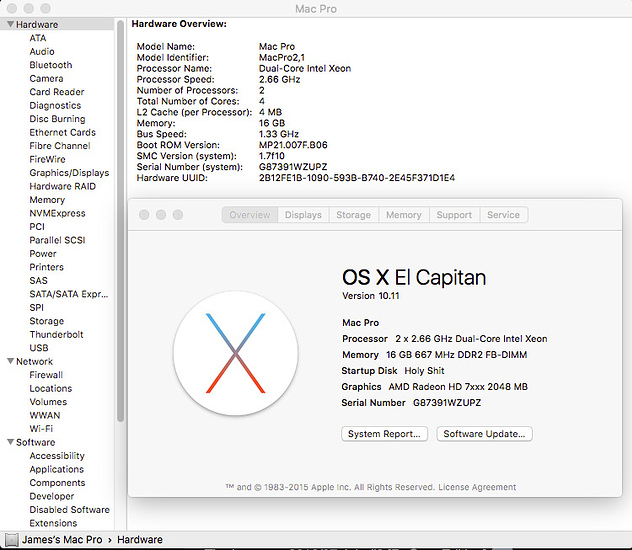This is a series. When I do others I will post them all towards each other at the bottom of the first post.
So earlier I posted this image.

I managed to get El Capitan on my mac pro 1,1. Not TOO difficult but the major problem is going to be getting some of the things you need... Them being:
- Mac Pro (1,1 or 2,1)
- 8GB USB or bigger
- 16 GB of RAM
- Dual Processors (I am personally recommending this but its not a real requirement)
- A Hard Drive (duh)
- The 1,1 to 2,1 firmware updater ( https://mega.nz/#!6AcSiIAR!dVq6o_p03J6g5gVMCV8y3kv0BrT6Gc4S1b0okxhBgoY my personal mega )
Key to that just in case: !dVq6o_p03J6g5gVMCV8y3kv0BrT6Gc4S1b0okxhBgoY - Piker USB tool ( http://forums.macrumors.com/attachments/pikify3-1-v12-zip.661799/ )
- El Capitan .app in your applications folder
You need at least 12 GB of ram to make the installer USB. I recommend 16 as, well, why not?
You should update your mac pro 1,1 to the 2,1 firmware before the install just in case. The tool itself has the instructions on how to use it.
So the basic process is
1. Format your 8GB or bigger USB to HFS Extended
2. Put you El Capitan.APP in your applications folder on your mac
3. Open up Pike's tool (I used V12) and open terminal
4. do ./pikecreatebootusb (or whatever the name of the exact script is in the file) /Volume/(yourusbvolumename). You can find this in disk utility.
5. Boot into the usb.
In the folder with the toolkit are some EFI files. These are modified files to make OSX boot on your mac pro 1,1. One has the new design that is a white bg and a black logo, and the other one is the older gray bg gray logo which I like more. The default is gray. You can copy it over if you really want or just ignore it. Its an aesthetic that will matter for all of 20 seconds.
Now install El Capitan.
My personal machine is:
Mac Pro 1,1 with 2,1 firmware
16 GB FB-Dimm ram
1tb HDD + 250gb HDD + 64 GB SSD
2 x cd drives
XFX R7 370 (El Capitan has drivers built in for the card)
An airport card not intended for this machine but works anyways
2 x 2.66 ghz xeon 5150 (soon to be x5355's when I have throwaway 20 bucks)
Now before you say "IT WON'T RUN WELL ITS SLOW AAAA" it runs fine. Just as well as if you updated ubuntu from 14.04 to 16.04. All that is added is some kernel improvements, ram improvements, microcode updates, visuals, and some apps. I played CSGo at 60 FPS earlier until the game crashed (it happens in osx, lol). I plan to either install windows or, in the event GCN 1 magically gets support, linux with amdgpu-pro drivers. Over all though this is probably the nicest machine I have ever owned. I'm happy to have it.
To anyone who doubts or has questions of performance, running 10.7 is no different to running 10.11. Theres 0 difference its just an arbitrary reason.
Video will be uploaded soon, but just a short take on my basic use of the machine. Gaming, YT, net, doesn't matter all too much.
MAJOR EDIT PLEASE READ IF YOU WANT TO UPDATE YOUR SYSTEM
I changed 1 link and it goes to the current version of the pikify tool (V12) and it includes "boot.efi' and "bootbase.efi". After you install your new system of El Capitan, make sure you either grab that file again or have it available and make a directory on your OSX EC system to store those 2 files. Now, in every tutorial online it will say "don't update you won't be able to boot". Your system will go into the recovery partition and tell you to reinstall or look online for answers. You do, however, have terminal access.
Now since you have terminal access you can access your files in your system. When you update, your base files in /System/Library/CoreServices are altered with the El Capitan combo update which updates EFI constraints. With your modified EFI files stored on your system, heres what you need to do to be able to boot back in.
Lets say your boot is `/Volumes/OSX', ok? I can only give an example for a system like mine where boot and storage are separated, but the rules apply the same. Just easier for me.
Example:
Boot: /Volumes/OSX
EFI's Stored: /Volumes/OSX-STOR/bootfix
......................your files will then be /Volumes/OSX-STOR/bootfix/boot.efi and /Volumes/OSX-STOR/bootfix/bootbase.efi
So, to fix your boot:
rm -rf /Volume/OSX/System/Library/CoreServices/boot.efi && rm -rf /Volume/OSX/System/Library/CoreServices/bootbase.efithis deletes the useless efi files
cp /Volumes/OSX-STOR/bootfix/boot.efi /Volume/OSX/System/Library/CoreServices && cp /Volumes/OSX-STOR/bootfix/bootbase.efi /Volume/OSX/System/Library/CoreServicesthis puts the modified efi files from your pre-stored directory into your boot-space so your system can start correctly.
These rules apply for any drive on your system. You could even have a USB with your bootfix stuff on it. If you DON'T know what drives are labeled what just open the terminal and do mount and look fou /Volumes/(driveNames) and you should be able to figure it out from there.
There is no way to permanently fix this that I know how to do unless there is a way to create a complete startup sequence via rootkit and I'm not going to get back into that XD. This is just my method, though you could do the same thing by downloading the tool files on a ubuntu liveUSB or whatever and just copying them over. Could be easier, but I dunno. This is just what I did.